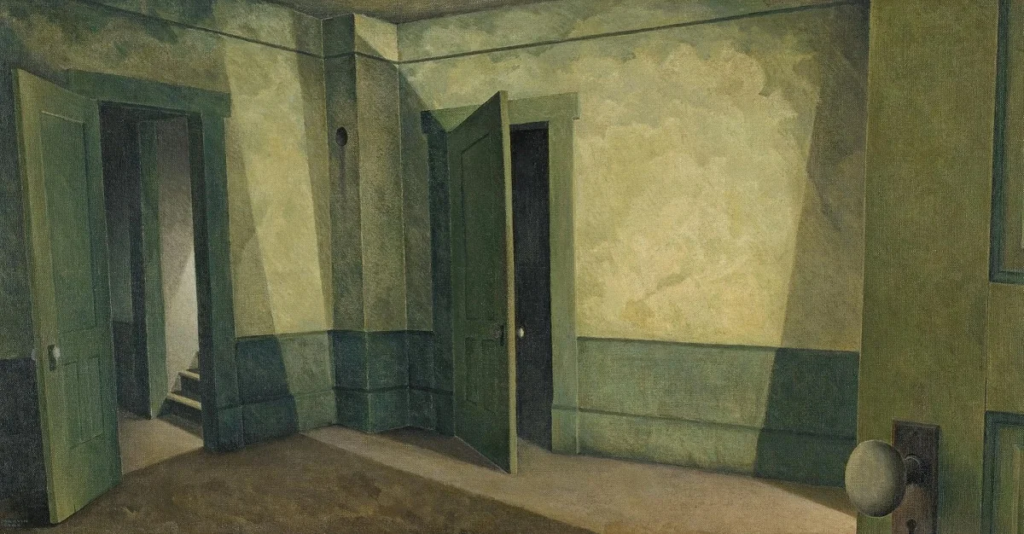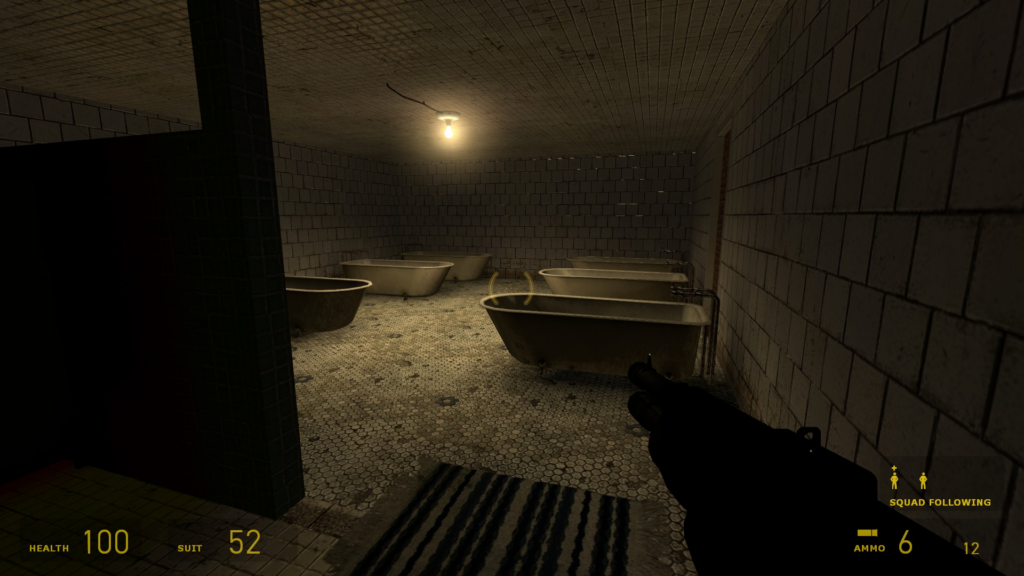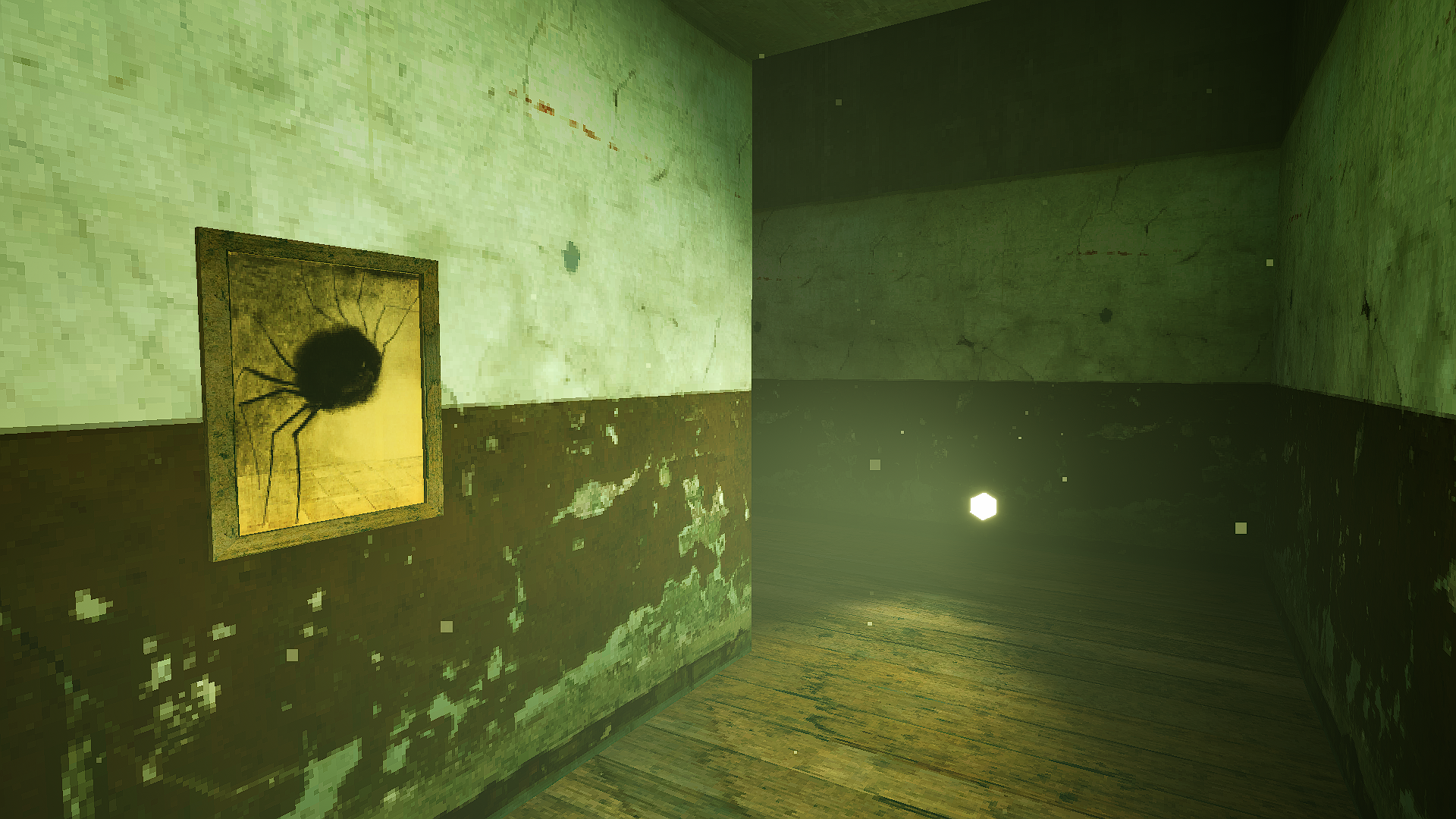This is an expanded version of the text file packaged with our game. If you haven’t played it, you can buy it here!
When I find something I like, my first instinct is to trace its artistic lineage. Primarily, this satisfies any lingering curiosity about the process of synapses: the moment when a bunch of unrelated ideas clunk together and gradually accrete until they miraculously gestate something new. But the real joy, I think, is when a work of art introduces you to older, weirder, and more outré forms of expression, or even just the immediate precursors to whatever you’ve already experienced.
Chiaroscuro Imago is our debut release under Howling Stars – a banner for the games created by Rachel (Gmad) and I. It’s only our first crack at creating something that’ll follow you to bed. We wanted something strange, suggestive, and above all else, different. I value fresh images, and though I won’t be surprised if various aspects of Imago don’t work for folks, I’m quite certain we’ve gotten at least one fresh image out of it. In the future, we hope to find even more.
Still, for every idea (or bee) that seems to come about through spontaneous generation, most of them result from that aforementioned synapse. Beyond the above, I had two hopes for the game. The first was for emotional efficacy – and if it got any kind of strong reaction out of you, I promise you “got it” as much as we hoped you would. As a corollary, the second was that someone would find it interesting. From here, a third, secret hope emerged: that anyone who played Chiaroscuro Imago could be briefly swayed into experiencing far cooler, weirder shit.
Unfortunately, I can’t give you a ton of that. Chiaroscuro Imago is a little esoteric by horror game standards, but not terribly so in the grander scheme of horror itself. Still, my present goal in life is to spread the good word of Interesting Art, no matter the vector. So here’s something self-indulgent: an enumeration of other work that, in some way or another, influenced our game. I recommend everything here wholeheartedly.
I hope you enjoyed Chiaroscuro Imago, and if you didn’t, I hope you’ll enjoy reading about the catalyst behind that sour taste in your mouth.
BOOKS
As the cheapest and most easily mutable tool at any game developer’s disposal, text (written or otherwise) is only secondary to good ambience in conjuring up genuine demons. Tragically, most (popular) horror games draw very little inspiration from literature – unless it’s, like, SCP or something. I find this frustrating! Not because I think that literati developers are guaranteed to make especially good games (though they tend to make them anyway), but because it feels like nothing whacks me out of an experience more than realizing that what I’m experiencing has a large, book-shaped hole in it.
You can’t create Silent Hill 2 without a team passionate enough to spin a psychological horror yarn around Dostoevsky’s Crime and Punishment, and yet a lot of folks seem to think they can make something as effective as Silent Hill 2 by… playing Silent Hill games. This remains a phenomena across a lot of art: compelling, diverse material getting attenuated through mirrored images, filtered through itself, functionally inbred. I think horror has it particularly bad, though. We live in a culture where postmodern reinterpretations of certain methods, modalities, and tropes easily become far more visible than the things they’re reinterpreting in the first place, and since horror is so easily commodified…
When it comes to videogames, I tend to think of this as the Undertale problem, since Undertale is an extremely popular game holding an intimate dialogue with a selection of games that are also extremely popular (Final Fantasy 7, Mother 3, et al.) but which the majority of its audience, rather inexplicably, never seems to play or even fundamentally attach to Undertale. It’s not that Bram Stoker’s Dracula isn’t well-known anymore; it’s that most people encounter adaptations and derivations long before they ever actually read it, if they ever do.
Anyway, I’m rambling. I think it’s hardly a coincidence that indie darling and noted Silent Hill successor Signalis wears its literary influences on its sleeve. Rather than inadvertantly reinterpreting a book they haven’t read, Signalis substitutes Crime and Punishment for sources like The King in Yellow. Similarly, House of Leaves is the lifeblood of MyHouse.wad, and don’t even get me started on Alan Wake 2. What about ANATOMY? One of my favourite short horror games, Chitin Creek, doesn’t even contain text, and yet its comprehension of weird fiction prefigures the entire experience.
For every interesting cinematic influence many of these games embody, a grasp on interesting prose seems to be their essential quiddity. My point is that, while there are a number of ways to make a really good horror game, a proximity to literature seems to encompass the medium’s most unplumbed depths. None of this is meant to suggest that our game will succeed on these merits – merely that, however unrefined, Chiaroscuro Imago was a game I wanted to play.
On the Oxen-born Bees of the Ancients – From which I cribbed the ending quotation, and from which a great deal of disparate insight was drawn. Having expected to skim it, I was shocked when I read the whole thing. It’s remarkable how entertaining an old book about science can be with the right subject and a certain amount of dry wit. After continually failing to produce a decent snippet of text to conclude the game with, it saved my ass when I stumbled over it towards the end of development. I am indebted to Carl Robert Osten Sacken. Thanks Carl! Sorry Carl.
The Georgics – It provided the opening quotation, obviously. But what The Georgics really represented to me was something new. While the game’s base premise was conceived before I learned about it, the moment when I actually discovered and started reading ancient agricultural poetry – its uneasy mixture of myth and antiquated practice, its didactic purpose muddied by a deluge of surreal, paganistic imagery – was the moment when I found a sensation worth recapturing in my writing.
House of Leaves – The explicit inspiration for coloring certain words, as was probably obvious. While people think of the word “house” and “minotaur” when they consider House of Leaves’ eye-catching highlights (and censorships), I’m always taken by the late usage of a purple sentence. It only occurs once, but that moment always sticks with me. It’s the one time when the base intention, rather than the explicit tonal intent, is unclear to the reader. I liked the idea of combining the novel’s unique form of sinister pattern recognition with the meaning-making of puzzling through an incomplete image.
Perdido Street Station – Insects have been synonymous with “horror” imagery for thousands of years, and absolutely none of it has scarred me deeper than the Slake Moth. The methods of their biology, the way they’re described… On my end of its design, I sent Rachel a bundle of the scariest fan renditions I could find as reference material, since I couldn’t fathom a scarier kind of bug (spiders being arachnids).
There’s also the matter of Miéville’s language, which brings us to a related topic…
Moby-Dick – It seems incongruous, but it actually had a major impact on my writing. The density of obscure, archaic, or even invented language, combined with several entire chapters dedicated to shadowboxing dead arguments while outlining the wonders of since-discarded branches of cetology, makes whaling feel like a kind of fissure into the most alien realities of the past. You slip into a separate way of being while holding a subtle point of reference, which is exactly what I was hoping to accomplish. Still, I’m not sure if my locution is there yet; but if I keep using the word “locution,” who knows?
Since I currently exist in that alien past, I’m not sure how folks are going to react to Imago’s writing. I’m hoping at least a few people “get” it, insomuch as they understand that not recognizing the word “repast” off the top of their heads is probably part of the point. I’m delighted when a game teaches me new words! I’m currently playing Sunless Sea, and it just used the word “quincunx” to describe a particular pattern. The psychic gift of language is such that now you, too, can now use the word “quincunx” to describe that pattern to somebody else. You won’t, but you could!!
Invisible Cities – Influenced a great deal of the game’s furtive cultural descriptions. Early on, I wanted to convey an environment that felt like it could exist in some disregarded corner of one of Calvino’s fictional lifeworlds. Hopefully I succeeded! If we’re lucky, an itch.io commenter will even compliment us for conveying an environment that “feels like it could exist in some disregarded corner of one of Calvino’s fictional lifeworlds” under a YouTube thumbnail of that person screaming at bugs.
FILMS
It’s Lynch.
I actually ended up being surprised by how little of the game ended up feeling like it was all that driven by movies. Ironically, we ended up haphazardly replicating portions of David Lynch’s secret strategy by drawing more from paintings and dreams than any other medium of visual art. I even grew up watching The Wizard of Oz! It took me too long to watch Sunset Boulevard though, and I still haven’t seen Vertigo. I’ve also watched several movies in the past few decades, which is anathema to the Lynch method. Better luck next time.
Jokes aside, I think it’s important to declare that we didn’t want to create something “Lynchian,” which is a term that I continue to (fruitlessly) insist means something specific. Rather than search for the macabre within the mundane, we wanted to do something inspired by Lost Highway’s haunted, caliginous tone. I would prefer to specifically cite that film rather than invoke Lynch’s name overarchingly, since I think it generally contributes to his flattening impression among medium dilettantes as The Weird Directior, as if “weird” can’t be laced with specificity or be made capable of any real articulation. Nonetheless, I still put his name on the store page – it was my single halfhearted attempt at marketing via neuron activation, rather than dumping pointed esoterica down and hoping it’d find the correct audience.
Towards the middle of development, I actually started to avoid movies that I felt would influence the game, since I was worried I’d return to Rachel and start suggesting random changes in a fit of hysterical tinkering. I especially avoided the films of Béla Tarr, whose work I can finally watch. If I’d watched it, I bet Werckmeister Harmonies would absolutely be on here. Now’s your chance to watch it before me!
Lost Highway – “Give me back my phone.”
What can I say? It’s a massive tribute to Lost Highway. Actually talking about how it’s a massive tribute to Lost Highway feels sorta elementary. If you’ve seen it, certain things will become jarringly obvious. Other things, however, might be less overt.
Everyone knows about the scene at the party. It’s the scariest scene in a movie next to, like, Pulse. But I always think about that scene near the beginning – the dark house, the potential intruder, the way he seems to disappear into the inky black before returning. That scene, in my opinion, is the scariest use of darkness in a film. It was on my mind frequently.
Twin Peaks – Particularly Mark Frost’s contributions to the show, given that Lynch’s side of the production is fairly well-trodden ground. Frost’s position as an occult “tourist” has given him the ability to digest the imagery of cults such as Theosophy, Thelema, et al. and export them while retaining the depth and consideration of such images. When this stuff reaches Lynch, he does incredible things with it, but I truly don’t believe he could get there without Frost. That bit in The Return where Cooper is in that strange, purple castle surrounded by the ocean? Absolutely influenced by Kenneth Grant’s “Mauve Zone” stuff. Frost doesn’t get enough credit!
Inland Empire – You’re just gonna have to take my word on this one.
PAINTINGS
I like when games have paintings in them, so the silk house displays a number of our public domain favourites. I tried to select pieces that weren’t obviously “creepy” or especially overutilized (à la Goya’s Black Paintings) and which didn’t fully showcase the human figure. Hopefully these saturate its atmosphere. They’re all listed in the attributions file!
This list contains some additional shouts to those painters whom I felt were especially important, either to me or Rachel, in establishing certain aspects of Chiaroscuro Imago’s visual mood.

Marvin Cone – With the silk house, we had two explicit goals: to portray a space that stemmed from foreign senses, and to avoid the growing tar pit of “liminal” or “elegiac” worlds. We avoided as much Backrooms or Backrooms-adjacent imagery as humanly possible. In their stead, we used the paintings of Marvin Cone, whose empty rooms and off-kilter doorways are so empty as to appear grisly. He gave us our start, but we could never seem to get far from him – the unfortunate reality of someone getting it right the first time.

Pieter Bruegel the Elder – A 16th century artist behind the defiled beekeeper portrait seen at the end of the silk house. Sometimes described as a “comic successor” to Hieronymus Bosch, he’s an artist whose work I find invokes the modern strangeness of medieval life: odd, isolated, and numinous. Ideally, if you’re borrowing from the imagery of a particular time period, you’re willing to go farther than just throwing it down and running away.

William Blake – Whose work actually appears in the game! He painted The Ghost of a Flea, which is probably one of my favourite paintings. But more than the piece itself, the ostensible tale behind it has always been a recurring image in my brain. To quote:
“The flea communicated to Mr. Blake what passed, as related to himself, at the Creation. ‘It was first intended,’ said he (the flea) ‘to make me as big as a bullock; but then when it was considered from my construction, so armed—and so powerful withal, that in proportion to my bulk, (mischievous as I now am) that I should have been a too mighty destroyer; it was determined to make me—no bigger than I am.”
In other words, one can interpret the eponymous Flea as a literal representation of what fleas would (and fictively did) look like in an age prior to their divine reduction. I love this because the Flea is basically an alien – it obviously looks nothing like a flea espied under the perceptions of a microscope, which suggests something beyond the typicalities of the Enlarged Bug. Big fan.
GAMES
From the beginning, we were aiming for something chiefly influenced by Lost Highway, nightpieces and strange, culturally outmoded objects. Since “walk around while scary things happen” is so ubiquitous, I wanted a horror game that was only minorly influenced by other horror games. I reckon that’s how you get stuff like ANATOMY or Paratopic. It’s the closest we can get to making outsider art, since we’re a. not outsiders and b. have been trapped here for the majority of our short lives.
Honestly, I talked about games too much in the section that was supposed to be about books, so I don’t have a lot to say here. Here are the important ones!
Hollow Knight – A few days before release, a friend who had just finished the game casually mentioned Hollow Knight in relation to certain elements of the setting, assuming direct influence. I was surprised – not because they were wrong, but because they were obviously right. I adore Hollow Knight, and I’ve finished it three or four times since release. But there was no mention of it recorded across anything related to the game’s development; not in a written conversation, not in any of my notes, nothing. Its presence, it seems, was entirely subconscious.
I find this absolutely nuts, and I’m submitting it here for fun’s sake. An article like this invariably presents the conscious Influence as the primary unit behind art, but for everything you set out to be influenced by, there are a ton of invisible forces driving you around.
ANATOMY – The first time I encountered a modern horror game that strived for esoterica. I can’t say a lot about it that hasn’t been said already, save that it does so much with so little. A casual, incredibly smart evolution of the form that supplants P.T.’s photorealism with an approach that anyone can learn from.
Thief: The Dark Project – Visually, tonally, spiritually. We just fucking love Thief, man. I had to stop writing a blog about Thief to write this blog about our game, and I’m going to keep writing that Thief article as soon as it’s out. If Rachel were here, she’d tell you about how thoroughly the game’s look was influenced by the lightmapped worlds of late 90s to early aughts first-person games. As for me, it’s the grounded, cascading surreality of those environments that really gets me. I could’ve easily put “The Thief Franchise (Except The Bad One)” here, but The Dark Project has all the wicked monster bullshit and tomb robbing in it. If you don’t like The Bonehoard mission, you may not survive the winter.
Just so we’re clear, “the bad one” is from 2014. I won’t be tolerating hateful attacks & crude comments about Deadly Shadows, which rules as much as it possibly could rule given the limitations imposed by its publisher. In particular, “Robbing the Cradle” majorly influenced all the ambience Rachel produced for the silk house. She’s so good, man.
Half-Life 2 – If you’ve read this far, you deserve a bonus, so here’s something that isn’t in the .txt that came with the game. For practical reasons, this is because listing “Half-Life 2” as a core influence with the words “bathtub room” is an alarming non-sequitur. Let me explain.

There’s a very strange room in Half-Life 2. Even if you’ve played it multiple times, I bet you haven’t seen it – at least, not consciously. It can be found in Anticitizen One, towards the game’s conclusion. In this room, which is located inside an equally strange apartment building, several bathtubs line the walls of a tiled, pool-like area. It’s off to the side, and nothing draws attention it. Like a lot of strange little areas, it’s easy to miss. When I first posted about it, a lot of dedicated Half-Life fans thought they were looking at a screenshot from a mod, having missed or overlooked it over a dozen playthroughs.
(And then an hour later, Sean Murray of No Man’s Sky fame reposted my screenshot on Twitter, which reached him through unknown means, and hundreds of No Man’s Sky players began to theorize that he’d specifically taken and posted it such that he could hint towards an update they assumed was forthcoming. Like the room itself, this was all very odd.)
The final fourth of Half-Life 2 is full of bizarre little spaces like this, infesting and germinating within empty rooms quickly filled in the frenetic rush to ship it on time. Much has been made of the Weird Videogame Room, from Super Mario 64 to Garry’s Mod. But I like this particular variant of it, with its obvious intent but skewered, ramshackle meaning, justified after the fact with a few choice visuals that never quite congrue. It feels like something you’d actually see in a dream, having clearly originated from the subconscious with only minor revisions imposed by the conscious brain (level designer).
Stuff like this was the primary objective for the silk house, and in drawing its layout, I specifically tried really hard to think about it as little as possible; I spent less than five minutes on it, and then, like a bewildered archaeologist, spent around 4000 words determining what I’d actually drawn. I’d love to post all that stuff, but I feel like people approach horror games of an uncertain meaning with a large degree of wikia theorycrafting instead of anything approximating, like, literary analysis. So I’m hoping to encourage that approach over the other. Still, I wrote a lot of text that I never intended anyone other than Rachel to read. It’d be fun to trawl through in the future!
Ultimately, Chiaroscuro Imago was our attempt to make something that patient, curious people can find interesting. If you’re still thinking about it a day later, we’ve succeeded. Here’s hoping!
For now, I’m not sure how much else I’ll write about our game. In truth, I feel drained just thinking about it – intently writing about something in private for the greater span of a year will do that. For the moment, we’re going to take a deserved break and then, hopefully, we’ll start creating something new.
There are a few frontiers I can imagine us reaching.

